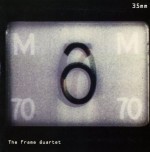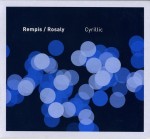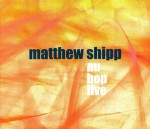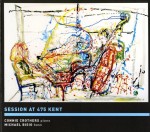Long-established jazz groups have become as common as pop hits based on Mozart melodies topping the charts – they sometimes exist. But with accomplished improvisers tempted by side projects, bands often reconstitute and sidemen regularly have their own gigs. In most cases, though, this doesn’t affect the music’s quality.
 Two bands confirm these realities. Ken Vandermark’s Vandermark5 (V5), which is at SPK (Polish Combatants Hall) June 17, has been together with only one personnel change for almost 15 years. Yet even Chicago-based Vandermark is involved in multiple side projects, as The Frame Quartet - 35 mm demonstrates. V5 members, cellist and electronics-player Fred Lonberg-Holm and drummer Tim Daisy are represented as well. Meanwhile saxophonist Dave Rempis, a V5 fixture for 10 years, shines on Cyrillic, a duo with drummer Frank Rosaly. New York pianist Matthew Shipp, whose trio plays June 13 at Gallery 345 on Sorauren Ave. is similarly part of numberless formations. Nu Bop Live involves some of his cohorts, who won’t be in Toronto. For an idea of what piano/bass communication sounds like involving Michael Bisio, the bassist who is in Shipp’s Toronto trio, there’s Session at 475 Kent with Connie Crothers.
Two bands confirm these realities. Ken Vandermark’s Vandermark5 (V5), which is at SPK (Polish Combatants Hall) June 17, has been together with only one personnel change for almost 15 years. Yet even Chicago-based Vandermark is involved in multiple side projects, as The Frame Quartet - 35 mm demonstrates. V5 members, cellist and electronics-player Fred Lonberg-Holm and drummer Tim Daisy are represented as well. Meanwhile saxophonist Dave Rempis, a V5 fixture for 10 years, shines on Cyrillic, a duo with drummer Frank Rosaly. New York pianist Matthew Shipp, whose trio plays June 13 at Gallery 345 on Sorauren Ave. is similarly part of numberless formations. Nu Bop Live involves some of his cohorts, who won’t be in Toronto. For an idea of what piano/bass communication sounds like involving Michael Bisio, the bassist who is in Shipp’s Toronto trio, there’s Session at 475 Kent with Connie Crothers.
 The Non-V5er on 35 mm (Okka Disk OD 12078 www.okkadisk.com) is Nate McBride, whose thick acoustic bass lines, electric bass thumps and manipulated wave forms distinguish this disc. Strident friction from Lonberg-Holm additionally gives the CD’s five long selections a rough-hewn quality, enhanced by Daisy’s reverberating and pinpointed cymbal slaps, not to mention Vandermark’s soloing which encompasses straight-ahead licks or tongue slaps on tenor saxophone and feathery clarinet trills. This is especially notable on Theatre Piece (for Jimmy Lyons) which links decisive sawing from the cellist, restrained plucks from the bassist and clatters, pops and rim shots from the drummer as Vandermark’s sound ranges from tremolo pitch-sliding on the clarinet to tongue-moistured saxophone flattement, flutters and split tones. Mid-way through, the tempo halves to allegro to expose faux romantic cello sequences that gradually shatters into sul ponticello lines mated with harsh, low-pitched saxophone rasps, balanced on crackling and buzzing electronics. Eventually the piece ends with an exposition of disconnected timbre-shredding from Vandermark and a conclusive string slap from the cellist.
The Non-V5er on 35 mm (Okka Disk OD 12078 www.okkadisk.com) is Nate McBride, whose thick acoustic bass lines, electric bass thumps and manipulated wave forms distinguish this disc. Strident friction from Lonberg-Holm additionally gives the CD’s five long selections a rough-hewn quality, enhanced by Daisy’s reverberating and pinpointed cymbal slaps, not to mention Vandermark’s soloing which encompasses straight-ahead licks or tongue slaps on tenor saxophone and feathery clarinet trills. This is especially notable on Theatre Piece (for Jimmy Lyons) which links decisive sawing from the cellist, restrained plucks from the bassist and clatters, pops and rim shots from the drummer as Vandermark’s sound ranges from tremolo pitch-sliding on the clarinet to tongue-moistured saxophone flattement, flutters and split tones. Mid-way through, the tempo halves to allegro to expose faux romantic cello sequences that gradually shatters into sul ponticello lines mated with harsh, low-pitched saxophone rasps, balanced on crackling and buzzing electronics. Eventually the piece ends with an exposition of disconnected timbre-shredding from Vandermark and a conclusive string slap from the cellist.
Halve the number of players and double the performance intensity for Cyrillic (482 Music 482-1064 www.482music.com). Completely improvised, the selections include those with cymbal-chiming funk grooves, replete with honking reed patterns, plus others featuring smeared double-tonguing from Rempis, where he never seems to stop for breath, matched with rim shots and side spanks from Rosaly. Most impressive are In Plain Sight and How to Cross When Bridges are Out. The former, which could be a deconstructed classic R&B line, gains its rhythmic impetus from Rempis’ guttural baritone saxophone snorts. The latter is like a face off between never-ending ratcheting, rolls and ruffs from Rosaly’s Energizer Bunny-like drumming and Rempis’ Eric Dolphyish-alto saxophone with its broken-octave staccato runs and wide split tones. Changing the agitato tempo to andante, the tune slips into uncharted aleatory territory, echoing with excitement and abandon.
 Both those adjectives are also on show on Shipp’s CD Nu Bop Live (Rai Trade RTPJ 0015 www.matthewshipp.com), especially on the 26-minute Nu Abstract suite. Putting aside the many-fingered staccato patterning on other tunes, the pianist initially restricts himself to occasional plinks, as drummer Guillermo Brown use electronics to unload crackling signal processing and hissing voice patches. After the pianist constructs a many-layered impressionistic response, he joins with William Parker’s fluid bass line and saxophonist Daniel Carter’s tightened reed snarls, in multi counterpoint. The performance swells to shrieking horn glossolalia, stretched and scattered bass-string movements and the pianist’s cascading note patterns. Climaxing alongside Brown’s explosions of drags and bounces, Shipp’s raw, exposed notes layer the interface alongside Carter’s strident altissimo cries and Parker’s triple-stopping.
Both those adjectives are also on show on Shipp’s CD Nu Bop Live (Rai Trade RTPJ 0015 www.matthewshipp.com), especially on the 26-minute Nu Abstract suite. Putting aside the many-fingered staccato patterning on other tunes, the pianist initially restricts himself to occasional plinks, as drummer Guillermo Brown use electronics to unload crackling signal processing and hissing voice patches. After the pianist constructs a many-layered impressionistic response, he joins with William Parker’s fluid bass line and saxophonist Daniel Carter’s tightened reed snarls, in multi counterpoint. The performance swells to shrieking horn glossolalia, stretched and scattered bass-string movements and the pianist’s cascading note patterns. Climaxing alongside Brown’s explosions of drags and bounces, Shipp’s raw, exposed notes layer the interface alongside Carter’s strident altissimo cries and Parker’s triple-stopping.
 Sophisticated piano-bass double contrapuntal interaction get an even better showcase on Session at 475 Kent (Mutable 17537-2 www.mutablemusic.com) as every tune is a culmination of Crothers’ thickly voiced, chromatic chords working out a challenge or response to Bisio’s chiming, slapping string reverberations. Chamber interludes, the CD’s four lengthy tracks evolve similarly to Resonance, the CD’s climatic finale. With Bisio double-stopping and pulling his strings fortissimo, Crothers’ glissandi and metronomic pumping, gradually give the sympathetic dynamic a novel undercurrent of unrelieved tension – embellished by the pianist’s strumming syncopation and the bassist’s woody string-stopping. Lightening her touch with freer harmonies, Bisio follows and shifts downwards into diminished pulses until the notes from both directions merge into a satisfying, protoplasmic whole.
Sophisticated piano-bass double contrapuntal interaction get an even better showcase on Session at 475 Kent (Mutable 17537-2 www.mutablemusic.com) as every tune is a culmination of Crothers’ thickly voiced, chromatic chords working out a challenge or response to Bisio’s chiming, slapping string reverberations. Chamber interludes, the CD’s four lengthy tracks evolve similarly to Resonance, the CD’s climatic finale. With Bisio double-stopping and pulling his strings fortissimo, Crothers’ glissandi and metronomic pumping, gradually give the sympathetic dynamic a novel undercurrent of unrelieved tension – embellished by the pianist’s strumming syncopation and the bassist’s woody string-stopping. Lightening her touch with freer harmonies, Bisio follows and shifts downwards into diminished pulses until the notes from both directions merge into a satisfying, protoplasmic whole.



